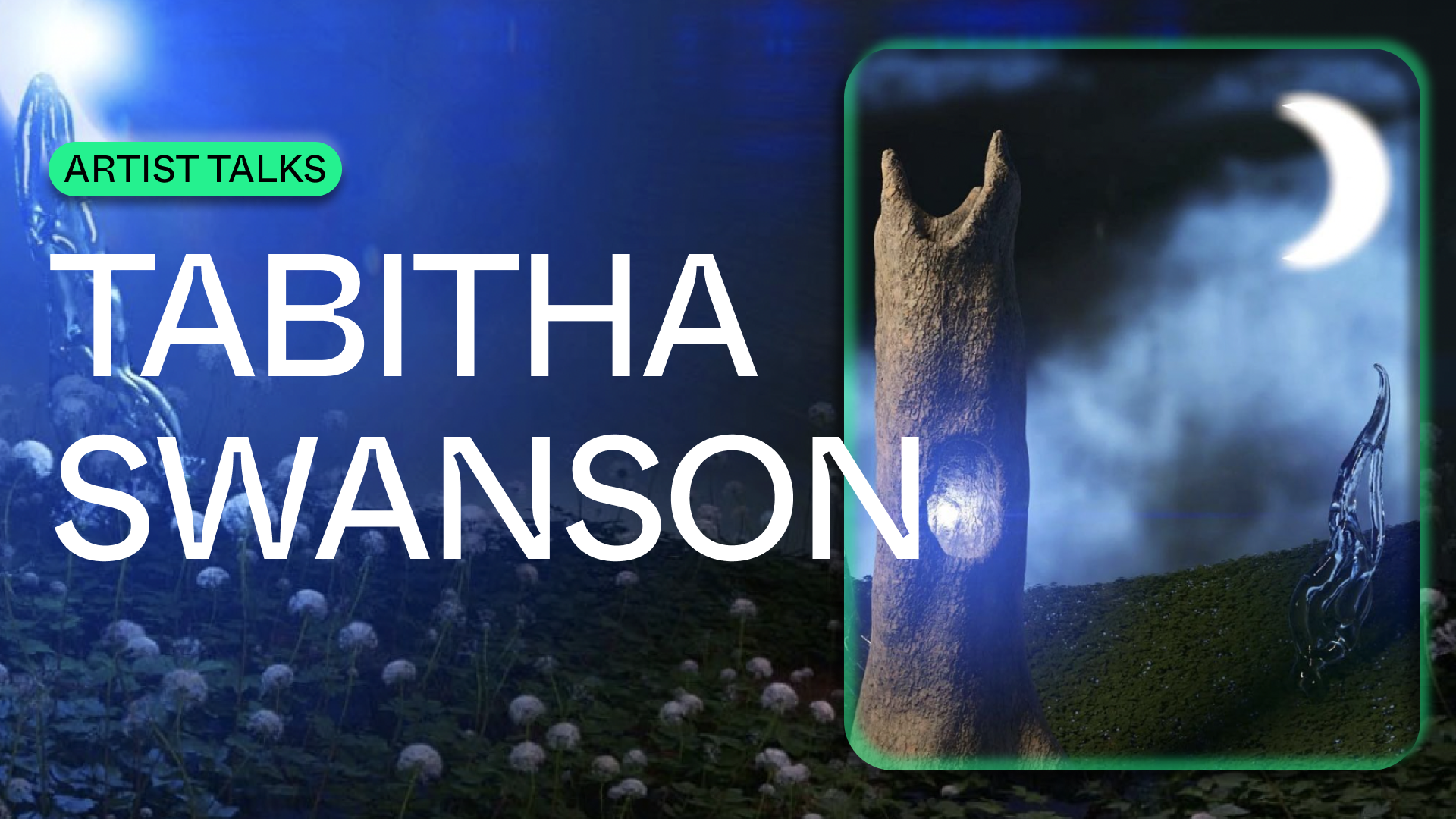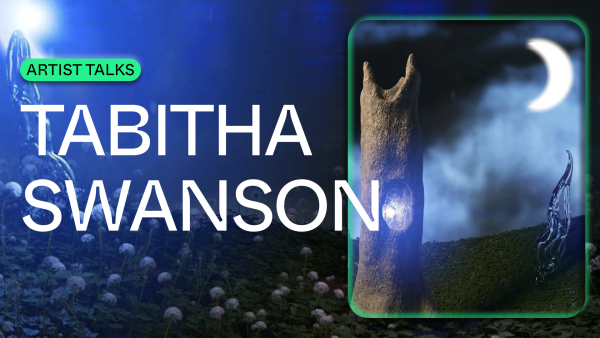Artist Talks: Tabitha Swanson On Unseen Edges.


In this week’s edition of Artist Talks, Palm NFT Studio welcomes Tabitha Swanson, a Berlin-based multi-disciplinary designer, creative technologist, and digital artist. Tabitha has worked with leading brands including Vogue, Nike, Highsnobiety, and more. Artistically, her work is used as a form of therapy, often composing questions rather than answers, and trying to faintly touch the unseen edges of human existence. Her practice includes an array of 3D art manifestations in the form of augmented realities, digital fashion, and ethical UI/UX designs.
How would you describe your work?
Definitely, for me, all of my work is trying to really touch on stuff that I think is unseen. Things that slip through the cracks of human existence that we all feel on some level, but maybe can’t always say, and I’m trying to describe how I feel those things in my own way through my art. I’m always interested in learning new tools, new digital platforms to try stuff out on, and then kind of learning the restrictions of each of those platforms, and seeing how that guides me…and how it guides the work.
"I never really liked sewing, but now I’ve been able to approach it from a new perspective and make clothes and the things that I want to make, but in a digital way".
Your artwork explores environments, both internally and externally. How do your surroundings influence your work?
I’m originally from Canada and I’ve lived in Europe for the past five years. Over the last years, I’ve been doing a lot more 3D work, AR, VR, and I’ve started doing digital fashion, as well, which is really fun for me. With the digital fashion stuff, it’s kind of a full circle because when I studied fashion, I never really liked sewing, but now I’ve been able to approach it from a new perspective and make clothes and the things that I want to make, but in a digital way. It’s also a really interesting conversation when you take into account sustainability and potential things for sharing that and distributing it in the future.
Describe the culture of digital art in Berlin. What does it feel and look like?
I think that Berlin is a really special place for the digital arts community. I’ve never been in a place where people just support each other and genuinely want other people to be doing well. I think a lot of that has to do with the degree of safety that’s here financially, whereas, in other big cities like New York or London, it’s a bit more cutthroat and cutthroat for many reasons.
When people are put in such a state of competition, maybe that can lead to less sharing of resources for certain people. In Berlin, you still have to work and make a living, but the quality of life here is better. There’s a good healthcare system and the school is free.
All those kinds of things, I think, alleviate some of the pressure and allow people to maybe create things that aren’t always for a commercial purpose. Maybe it gives them a little bit more space to experiment, have fun, and just be a bit more free-flowing. Not to say that doesn’t happen in New York and London, because that’s happening in abundance there. Both of those cities are incredible and kind of the meccas for art in many ways. Yeah, but just different.
What was your first introduction to Web3 and NFTs, or non-fungible tokens?
I am kind of newer to NFTs. I started doing it a little bit in February of this year, but then I got COVID and I just had a bit of a long-winded thing with that. And maybe it seemed a little scary or I built it up in my head, but when I started doing it, honestly, the community has been super nice. I have been on Twitter more and the NFT community is literally one of the most positive communities on Twitter. Everyone there is super supportive, hyping each other up, and trying to provide visibility to people…especially people who are newer, earnest, and trying to just make a living off of their art and what they do. I think that NFTs have sparked some really interesting conversations about some barriers that were previously there in the fine art world, and still are.
This is a whole new dimension to art. It allows for different avenues of understanding what art is or what it could be as well as different ways of having remuneration for making your art.
"I think that if anything, it allows artists, once they’re kind of in the flow of it, to maybe even take a road of diving deeper into their own practice without this kind of commercial aspect at the end of it".
You’ve mentioned that your art also acts as a form of digital therapy...
Yeah, totally. I think that if anything, it allows artists, once they’re kind of in the flow of it, to maybe even take a road of diving deeper into their own practice without this kind of commercial aspect at the end of it. I think that’s when I make the best art; when it’s coming from a place of feeling, from my core. The ability to be able to think about using that pure essence of expression and being able to potentially make a living off of that is probably the most appealing thing that I could think about doing.
What inspired you to create your latest collection with Portion?
Yeah, so that one is from the digital fashion line that I started called All the Hidden Things. For me, it was being kind of cooped up in my house and not really being able to go out anywhere. I really love dressing up and wearing costumes and everything. Maybe the inability to do that in real life in the same way that I could before was kind of pent up inside of me and I wanted to be able to have a way to have fun with clothing and that sort of expression. The creation of digital clothing was a really fun outlet for that.
I was really thankful to be asked by Portion to come on board for their Digital Fashion Month alongside some other artists that I admire and look up to like The Fabricant and Andy Rofles. My piece is called Honey. For that one, it was kind of a sweet piece with the pink and the fur, but it’s also a bit of a spicy piece with a thong and stuff. But it’s really cool.
Do you see a future where people are particularly able to where wear these items?
We can already see with Snapchat that you can place full-on augmented reality outfits within a filter and people can wear them. I think that’s super cool and not only is it fun, interesting, and useful for marketing, but it’s actually something that can also be utilized for being more sustainable in ways that are maybe less expected.
I used to work at a fashion company here in Germany in a tech department, but I helped very briefly with a project where they were trying to design apps that were either 3D scanning people, or having an app that can give measurements when people spin around, and then kind of a projected idea for that was, “Well, can we allow people to try it on?” And I mean, we’re already seeing that on a smaller scale with companies that have access to larger tech budgets, they’re allowing people to go in front of screens and see what their clothes look like on them.
You’re also a part of the collective Digi-Gal, an online platform for women to connect with others in their industry.
Digi-Gal was started by Catty Tay who’s based in London and it’s full of people from all over the world. It’s fem, trans, and non-binary identifying people who are looking for a safe space to just learn, do 3D and connect on that level. That’s been a group where people are really sharing resources and really trying to help each other and I’m really thankful for it. I think that the crew here in Berlin has kind of even gone past just being part of Digi-Gal together because we’re all just buds now, and we just hang out outside of the context of the group all the time.
What do you feel can be improved in terms of accessibility for the world of web 3.0 in order to get more people to be safe and to feel comfortable interacting with this new ecosystem?
After so many years of doing UX and UI, one thing I’ve learned from it is that websites are always inflow. You’re always iterating and reiterating, plus getting that first initial launch can take a long time to get right, or just be costly because you have to hire a lot of designers to work on it and work out all the bugs.
What projects or artists are inspiring you right now? What are you checking out in regards to NFT projects or intriguing artists that are also in the scene?
Yeah, totally. So I think something I’ve really enjoyed seeing recently has been, I think it’s called Magma World. It’s this group of brilliant Brazilian artists. Their work is spectacular and really amazing. What really stands out to me is how much this group just supports each other and sticks to repping each other’s work. It’s so positive to see. I really like Gabriel Massan‘s work. They’re also from Brazil and were also part of the Magma release at one point, but I think that they’ve really created a universe as something you can really get lost in and want to collect. I also really like Aevtar Perform’s stuff. They come from a background of performance art, and acting, and singing, and their stuff is always very experimental, which I like.
Where do you see the next mediums evolving in regards to digital art?
I’m really curious where the boundaries of NFTs will go and maybe the legal things around it. My one friend, Nico, 3D scanned their butt and minted that. Now I’m curious: will people be minting their organs? What is the extent of it? How is that experience going to happen? Yeah, I would love to have holograms, though, to answer your question.
Explore more from Tabitha Swanson on:







